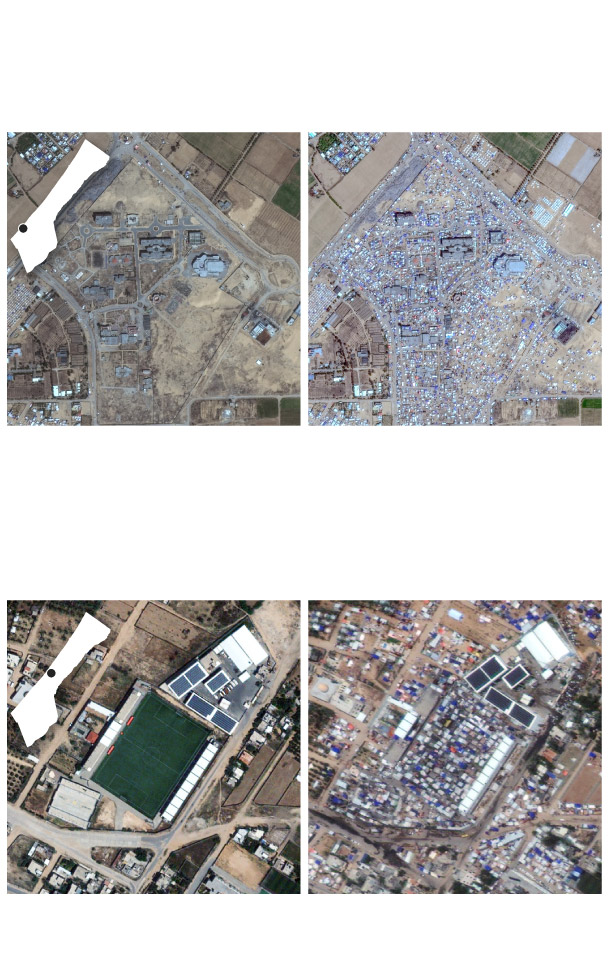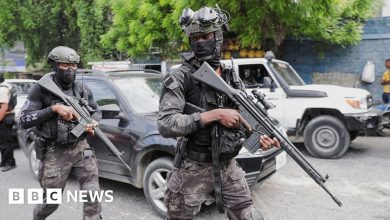Gaza families search for safety and shelter as Israel moves into Rafah

Deir al-Balah, central Gaza
Source: Maxar Technologies

Deir al-Balah, central Gaza
Source: Maxar Technologies

Deir al-Balah, central Gaza
Source: Maxar Technologies

Deir al-Balah, central Gaza
Source: Maxar Technologies

Deir al-Balah, central Gaza
Source: Maxar Technologies
These staggering figures – more than 150,000 people have fled in the last 48 hours alone – are expected to continue to rise as Israeli forces move deeper into Rafah, Gaza’s southernmost town, which until recently was considered a “safe zone” by Israel and was home to about half the population. of the 2.2 million inhabitants of the Gaza Strip. Since May 6, Israel has issued evacuation orders for eastern Rafah and asked residents to head north to designated “humanitarian zones.”
In a dozen telephone interviews over the past week, Gazans described having to make agonizing choices: to leave, where to go and how to survive. “Gaza has become like a ghost town for me, unfit for human life,” said Shireen Abu Qamar, 36, between network outages in western Rafah.
Israel will do “whatever it takes to win this war,” Israeli Prime Minister Benjamin Netanyahu said Wednesday, defending the Rafah assault as essential to defeating Hamas’s last intact battalions.
The Israeli military described the operation as “limited,” but it has already had a massive impact on civilians, many of whom had found some stability, however precarious, in Rafah after months of hunger and bombing.
Abu Qamar fled with his family from the Beit Hanoun refugee camp in the north of the country at the start of the war after their house was hit in a strike. They were uprooted six times in seven months.
“The journey of displacement nevertheless continues,” she said.
The former journalist spoke this week from a makeshift UN-run camp in Tel al-Sultan, just outside the Israeli evacuation zone, where she has been living since February in a hand-sewn tent. hand with her husband and three children. His youngest son, Mohammed, was badly burned in a strike on a relative’s house that killed four family members. Every day, she said, her children ask, “When will we return to our house and our toys?”
As of Wednesday, only about 30 people remained in a camp that once held more than 500, she said, as families rushed to stay ahead of the Israeli advance.
Abu Qamar also tried to leave.
West of Khan Younis, about five miles away, seemed like the safest bet, she said. She had family there, themselves displaced from the eastern part of the city. It was a little “reassuring” that the Israeli army told people to go there, she said, “but based on previous experience, there is no safe place.”
On Tuesday, the family secured a coveted and expensive ride to Khan Younis, but decided not to go when relatives warned about conditions there.
“In Khan Younis, there is severe population congestion and incredible overcrowding,” Abu Qamar said, weighing the risks. “Water is not available and displaced people are traveling longer distances to buy water. »
In Rafah, she at least had free water and space for her tent. Food was starting to run out, but that was true everywhere.
“Since the army entered Rafah and closed the crossing, we have not received any aid (from the UN) and there is no food,” she said on Wednesday. A cheese sandwich was all she ate that day; in the background she could hear the detonations of airstrikes and artillery.
Forty-year-old Wissam picked up his children and fled Rafah last week. He spoke to the Post on the condition that only his first name be used because he feared for his safety.
Wissam lived in El-Jeneina, in downtown Rafah. Unlike most Gazans, this trader was able to stay at home throughout the war. “I had solar panels, water, internet and security,” he said Monday.
The Wissam neighborhood was not part of the initial evacuation zone. When the Israeli orders were issued on May 6, he figured he still had time. The next day, the IDF launched an intense bombing campaign in al-Jeneina, which it said targeted Hamas fighters and infrastructure. Wissam’s children – aged 2, 4 and 6 – were terrified.
On May 9, Wissam decided they had to leave. He left with his extended family around 10 a.m. It took six hours to travel the eight kilometers to Mawasi, carrying everything they could: mattresses, blankets, plates, cups, a jug of water, the canned goods they had saved.
“The roads were crowded and children were screaming,” he said.
The Israeli military has described the coastal area of Mawasi, as well as parts of neighboring Khan Younis and central Deir al-Balah, as an “extended humanitarian zone” where civilians “will receive water, food, medical supplies and shelters.
Wissam found none of this when he arrived in Mawasi. Unable to find a tent – which is expensive and difficult to find – he designed a makeshift shelter with sticks and blankets. It’s scorching hot and they only spend the night indoors.

Source: Maxar Technologies

Source: Maxar Technologies

Source: Maxar Technologies

Source: Maxar Technologies
“I have no bathroom, no food, no water,” he said. Internet and phone service is minimal.
“Death wouldn’t be any harder.”
Cramped conditions and poor sanitation are likely to be a breeding ground for infectious diseases, health groups have warned, but Wissam said the nearest clinic is miles away.
But it is not possible to return to Rafah. On Saturday, the IDF expanded its evacuation zone to include al-Jeneina. Three days later, Israeli tanks entered his neighborhood.
Humanitarian agencies have said for months that Mawasi – an agricultural area before the war – did not have the infrastructure to accommodate large numbers of displaced Palestinians. The sudden eruption of fighting and Israel’s seizure and closure of the Rafah crossing cut off humanitarian agencies from their storage centers and left them with little food or fuel to distribute.
A small number of aid trucks passed through the Kerem Shalom crossing last week – reopened by Israel after Hamas rocket fire – but access is through the evacuation zone.
Humanitarian operations in Gaza are “stalled” and “unpredictable”, UN humanitarian chief Martin Griffiths said on Thursday. Famine, he said, was an “immediate” danger.
“We have been trying to deliver aid from Kerem Shalom for some time, but we need adequate security and coordination from the authorities that will allow us to deliver aid across the river. border inside Gaza safely,” said one aid worker. speaking on condition of anonymity to discuss a sensitive issue. “The roads around the crossing are dangerous, unfit for traffic or overcrowded” with displaced people.
Washington, which has always opposed a “major offensive” in Rafah, had also insisted that any operation there be accompanied by a credible Israeli plan to evacuate civilians.
“The problem now is that there are very few places they can go inside Gaza and there is no effective way to distribute aid to them and ensure that they have access to shelter, to sanitation facilities, to places where they would go,” the state said. Department spokesman Matthew Miller said May 6. As Rafah empties and the humanitarian disaster in Gaza spreads, U.S. officials maintain that the Israeli campaign there has not crossed Biden’s “red line.”
“What we understand is that these operations are targeted,” White House press secretary Karine Jean-Pierre said Wednesday. “They are limited. That’s what we were told. We will continue to monitor the situation.
Gazans who cannot flee Rafah on foot have few means of transportation. Fuel prices have skyrocketed due to shortages. A trip out of town can cost at least $200, and often much more, according to Palestinian residents and drivers, whose numbers are posted on Telegram by displaced families.
Out of 14 numbers called, The Post was only able to reach three drivers. Two said they could no longer offer rides: one had his truck’s battery stolen, another couldn’t afford fuel.
Mohamed Khaled, his parents, two sisters and four brothers paid $700 on Monday for a ride from Rafah to the al-Bureij refugee camp in central Gaza.
He wished they didn’t have to leave. “All the aid was in Rafah,” he said. “There is no security in all of Gaza, but Rafah was better in that sense. »
Her family, now on their ninth move, shares a two-room house with another sister, her husband and two children. The building was damaged by a bombing last week, he said, but it still stands.
“I don’t feel anything,” he said. “We got used to this.”
Hazem Balousha and Heba Farouz Mahfouz in Cairo contributed to this report.
News Source : www.washingtonpost.com
Gn world




